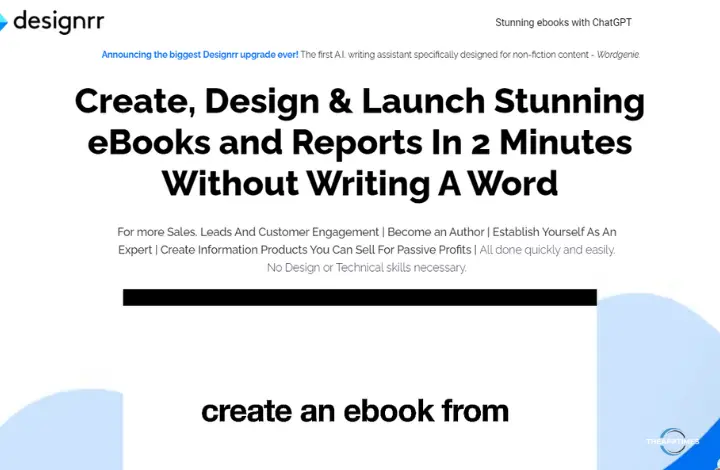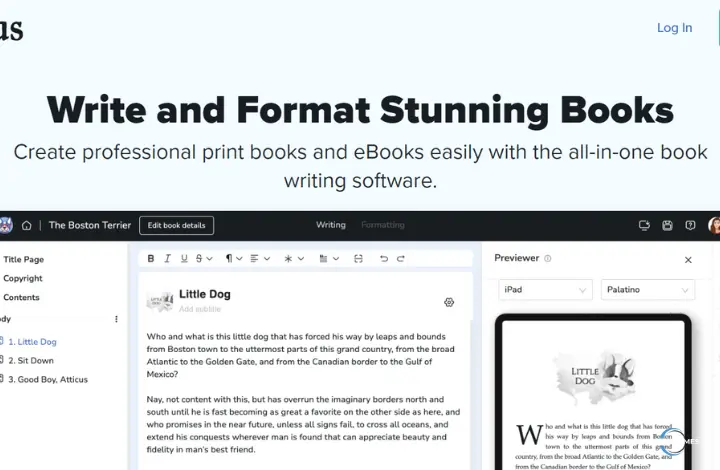In the ever-evolving digital landscape, eBooks have emerged as the go-to format for authors, marketers, and content creators alike. The demand for cutting-edge eBook creation tools has reached new heights, empowering creators to craft compelling digital experiences. If you are an aspiring writer, a seasoned marketer, or an educator seeking to share your expertise, the right eBook software can be the key to unlocking your creative potential.
From intuitive interfaces to advanced formatting options, the top eBook creator tools of 2024 are poised to revolutionize the way we consume and distribute digital content. In this article, we bring you the top eBook creation platforms that are set to dominate the market in the coming year. We explore the unique features, benefits, and use cases of each tool, equipping you with the knowledge to select the perfect solution for your eBook publishing journey.
Best eBook Creation Tools for 2024
Canva

Canva is a versatile design platform, but has firmly established itself as a go-to choice for eBook creation. Boasting an intuitive drag-and-drop interface and a vast library of pre-designed templates, Canva empowers even the most design-averse individuals to craft visually captivating eBooks.
Beyond the user-friendly tools, Canva’s standout feature lies in its extensive collection of stock images, graphics, and design elements. With just a few clicks, you can seamlessly incorporate high-quality visuals into your eBook. This is sure to elevate the overall reading experience for your audience.
Canva’s flexible design capabilities make it an excellent choice for authors, marketers, and educators alike. Your eBooks can have a sleek and minimalist look or be a vibrant, illustration-rich digital publication. Plus, its collaborative features further enhance the eBook creation process. It allows you to work in tandem with editors, designers, and other team members as well.
Microsoft Word
Microsoft Word, the ubiquitous word processing software, has long been a staple in the world of eBook creation. While it may not be specifically designed for eBook publishing, Word’s well-established formatting tools and widespread familiarity make it a reliable choice for authors who prioritize a streamlined eBook creation process.
One of the primary strengths of using Microsoft Word for eBook publishing lies in its ability to handle PDF exports, a format that is widely accepted across various eBook platforms and devices. This simplifies the distribution process, allowing authors to focus on crafting their content without the added complexity of format conversions.
Additionally, Word’s pre-designed eBook templates and style options enable authors to achieve a professional, polished look for their digital publications. This can be particularly beneficial for those who may not possess extensive design expertise but still want to deliver a visually appealing eBook to their readers.
Adobe InDesign
For authors and publishers seeking the ultimate in eBook design control, Adobe InDesign stands out as the industry-leading solution. As part of the renowned Adobe Creative Cloud suite, InDesign offers unparalleled capabilities when it comes to creating visually stunning, interactive eBooks.
InDesign’s powerful layout tools, advanced typography options, and seamless integration with other Adobe applications make it the go-to choice for professional designers, publishers, and authors who demand the highest level of design flexibility. Whether you’re crafting complex, multimedia-rich eBooks or meticulously curating the typography and page layouts, InDesign provides the granular control necessary to bring your eBook vision to life.
While the learning curve for InDesign may be steeper compared to some other eBook creation tools, the investment in mastering this software pays dividends in the form of truly exceptional eBook designs. InDesign’s collaborative features also make it a valuable asset for teams working on eBook projects, ensuring a cohesive and polished final product.
Scrivener
Scrivener, the acclaimed writing software, has long been a favorite among authors for its powerful eBook creation capabilities. Designed with the needs of writers in mind, Scrivener offers a comprehensive suite of tools that streamline the entire eBook publishing process, from initial content creation to final formatting and compilation.
One of Scrivener’s standout features is its ability to seamlessly manage long-form projects, making it an ideal choice for novelists, non-fiction writers, and anyone tackling extensive eBook projects. The platform’s intuitive corkboard and outlining tools allow authors to effortlessly structure their content, while the built-in formatting options ensure a professional-grade eBook output.
Scrivener’s versatility extends beyond just eBook creation, as it also supports the export of manuscripts to various other formats, including EPUB, MOBI, and PDF. This flexibility allows authors to cater to the diverse reading preferences of their audience, further expanding the reach and accessibility of their digital publications.
Kindle Create

This tool is for authors and publishers focused on the Kindle ecosystem. Kindle Create is a dedicated eBook creation tool that simplifies the process of producing content tailored for Amazon’s popular e-reader platform. Developed by Amazon, Kindle Create offers a user-friendly interface and a range of pre-designed themes. This is to ensure that your eBooks are optimized for seamless display on Kindle devices.
One of the key advantages of Kindle Create is its tight integration with the Kindle Direct Publishing (KDP) platform. This streamlined integration allows authors to effortlessly publish their eBooks on the Kindle Store. Additionally, Kindle Create’s built-in preview mode enables authors to see how their eBooks will appear on various Kindle devices. This facilitates a polished final product.
While Kindle Create may have a more limited set of design options compared to some other eBook creation tools. But, its focus on Kindle optimization and seamless KDP integration make it a compelling choice for authors who want to maximize their reach within the Amazon ecosystem.
Kitaboo
Kitaboo, is a cloud-based eBook creation platform. It stands out for its exceptional capabilities in developing interactive, multimedia-rich eBooks. It is designed with educators, corporate trainers, and content creators in mind. Kitaboo empowers users to incorporate a wide range of engaging elements, including videos, audio, quizzes, and assessments, into their digital publications.
One of Kitaboo’s key strengths lies in its robust digital rights management (DRM) features. These features ensure secure distribution and prevent unauthorized access to your eBooks. Kitaboo is therefore, an attractive choice for organizations and institutions that require a high level of content protection. For example, institutions such as schools, colleges and corporate training departments.
Kitaboo also boasts a user-friendly interface and a comprehensive set of authoring tools. This combination allows even non-technical users to create visually appealing, immersive eBooks.
Designrr

Designrr is an innovative eBook creation tool that sets itself apart by offering a unique content repurposing capability. Rather than starting from scratch, Designrr enables users to seamlessly transform their existing content, such as blog posts, videos, and podcasts, into professionally formatted eBooks.
This time-saving feature is particularly appealing to content creators, marketers, and subject matter experts. That’s because they most likely have already invested time and effort into developing valuable resources.
Designrr’s intuitive interface and AI-powered assistance lets users focus on curating their content rather than grappling with complex formatting requirements.
Designrr also provides a wide range of customizable templates, a comprehensive image library, and advanced editing tools. This ensures that even users without extensive design expertise can produce visually engaging eBooks that align with their brand and messaging.
Vellum
For writers who prefer a Mac-centric eBook creation experience, Vellum stands out as a powerful and user-friendly solution. Vellum is designed specifically for the Apple ecosystem. It offers a streamlined interface and a range of features that simplify the eBook formatting process. This ensures a polished and consistent look across various digital platforms.
One of Vellum’s key strengths lies in its ability to handle complex formatting tasks, such as managing margins, headers, and footers. The platform’s pre-designed Book Styles lets users to quickly apply professional-grade layouts and typographic elements to their digital publications.
Additionally, Vellum’s built-in preview functionality allows authors to see how their eBooks will appear on different devices, including Kindle, Apple Books, and Kobo. This real-time feedback allows for seamless adjustments and fine-tuning.
Its focus on delivering a polished, professional-grade eBook creation experience has made it a popular choice among Mac-centric authors and publishers.
Atticus

Atticus is another popular and comprehensive eBook creation and publishing platform. It aims to streamline the entire eBook production process, from manuscript to final publication. Designed with authors in mind, Atticus offers a user-friendly interface. It also has a robust set of features that cater to both the writing and formatting aspects of eBook creation.
One of Atticus’ standout capabilities is its granular control over eBook formatting. It allows users to customize everything from chapter styles and fonts to drop caps and ornamental breaks. Combined with pre-built themes and intuitive tools, even non-technical users without extensive design expertise can create visually stunning eBooks.
Furthermore, Atticus’ cloud-based nature ensures that authors’ work is always accessible and secure, even if their device encounters any issues. Coupled with its collaborative features, this is an attractive choice for authors who prefer to work in a team-based environment or across multiple devices.
Atticus aims to simplify the entire eBook journey, from initial content creation to final distribution. This makes it a compelling choice for authors seeking a streamlined and efficient eBook publishing experience.
Conclusion
As the digital publishing landscape continues to evolve, the array of eBook creation tools available in 2024 promises to unlock new levels of creativity, accessibility, and engagement for authors, marketers, and educators alike.
Whether you’re an aspiring writer a marketer aiming to captivate your audience with visually stunning eBooks, or an educator looking to develop interactive, multimedia-rich digital publications, these top eBook creator tools offer a diverse range of solutions to suit your specific needs.
Leveraging the power of these cutting-edge eBook creation platforms to elevate your digital content, reach a wider audience, and ultimately achieve your eBook publishing goals. Embrace the digital revolution and let your ideas take shape as virtual masterpieces that captivate, educate, and inspire your readers.
As you embark on your eBook creation journey, remember that the key to success lies not only in the software you choose but also in your dedication to crafting compelling, well-designed content. By combining the right eBook creation tools with your unique creative vision, you can unlock a world of possibilities and leave an indelible mark on the digital publishing landscape.
If there are other tools that you are using with remarkable success, let us know in the comments section.
Leave a Reply